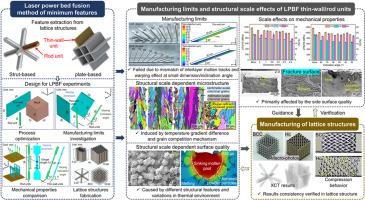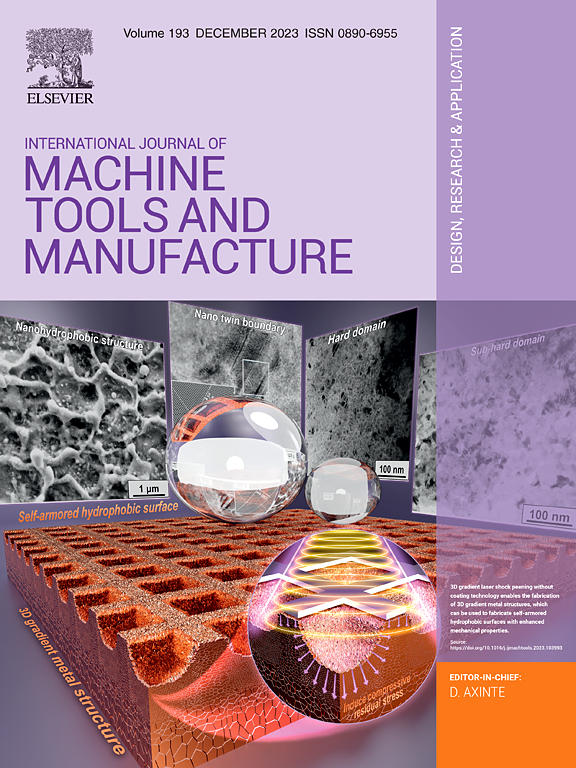Manufacturing limit and structural scale effect of thin-wall/rod units in lattice structure fabricated by laser powder bed fusion
IF 18.8
1区 工程技术
Q1 ENGINEERING, MANUFACTURING
International Journal of Machine Tools & Manufacture
Pub Date : 2025-08-28
DOI:10.1016/j.ijmachtools.2025.104323
引用次数: 0
Abstract
The growing maturity of additive manufacturing (AM) technologies, represented by laser powder bed fusion (LPBF), has greatly facilitated the design and manufacturing of lattice structure. However, the process constraints of the minimum features (thin-wall/rod units) in lattice structure remains poorly understood. This study investigated the manufacturing limits and the relevant failure mechanism of thin-wall/rod units fabricated by LPBF. The effects of structural scale (dimension and inclination angle) on surface morphology, microstructure, and mechanical properties were also studied. Results indicate that the failure of thin-wall/rod units at critical dimension and inclination angle was driven by interlayer molten track mismatch and warping effect in cantilever region, respectively. AM process simulations reveal that rod unit exhibit better manufacturability at small inclination angles compared to thin-wall unit, due to less significant stress deformation. A clear dependence of defect behavior, surface morphology and microstructural characteristics on structural scale is identified. A multi-physics model was created to observe the development of down-skin surface quality of the thin-wall units at small inclination angles. Microstructural analysis reveals transitions between super-refined equiaxed grains, millimeter-long columnar grains, and centimeter-long columnar grains at different scale governed by temperature gradient and grain competitive mechanisms. Additionally, a declining tendency in tensile strength is detected with decreasing feature dimension and inclination angle, primarily because the poor side surface quality and higher porosity accelerated crack initiation and propagation. Moreover, two types of lattice structures were fabricated accordingly. Their characterization results confirm the applicability of the new findings from thin-wall/rod unit experiments, providing insights for the efficient manufacturing of lattice structures endowed with excellent performance.

激光粉末床熔合薄壁/棒晶格结构单元的制造极限及结构规模效应
以激光粉末床熔融(LPBF)为代表的增材制造(AM)技术日益成熟,极大地促进了晶格结构的设计和制造。然而,晶格结构中最小特征(薄壁/棒状单元)的工艺约束仍然知之甚少。研究了LPBF薄壁杆件的制造极限及其失效机理。研究了结构尺度(尺寸和倾角)对表面形貌、显微组织和力学性能的影响。结果表明,薄壁/杆单元在临界尺寸和倾斜角度下的失效分别由层间熔迹失配和悬臂区域翘曲效应驱动。增材制造过程模拟表明,与薄壁单元相比,棒材单元在小倾角下具有更好的可制造性,因为应力变形较小。缺陷行为、表面形貌和微观结构特征对结构尺度有明显的依赖性。建立了多物理场模型,观察了小倾角下薄壁单元的下表皮质量的变化。显微组织分析揭示了不同尺度下超细化等轴晶、毫米长柱状晶和厘米长柱状晶之间的转变受温度梯度和晶粒竞争机制的控制。拉伸强度随特征维数和倾角的减小呈下降趋势,主要原因是侧表面质量差、孔隙率高加速了裂纹的萌生和扩展。并据此制作了两种类型的晶格结构。他们的表征结果证实了薄壁/棒单元实验新发现的适用性,为高效制造具有优异性能的晶格结构提供了见解。
本文章由计算机程序翻译,如有差异,请以英文原文为准。
求助全文
约1分钟内获得全文
求助全文
来源期刊
CiteScore
25.70
自引率
10.00%
发文量
66
审稿时长
18 days
期刊介绍:
The International Journal of Machine Tools and Manufacture is dedicated to advancing scientific comprehension of the fundamental mechanics involved in processes and machines utilized in the manufacturing of engineering components. While the primary focus is on metals, the journal also explores applications in composites, ceramics, and other structural or functional materials. The coverage includes a diverse range of topics:
- Essential mechanics of processes involving material removal, accretion, and deformation, encompassing solid, semi-solid, or particulate forms.
- Significant scientific advancements in existing or new processes and machines.
- In-depth characterization of workpiece materials (structure/surfaces) through advanced techniques (e.g., SEM, EDS, TEM, EBSD, AES, Raman spectroscopy) to unveil new phenomenological aspects governing manufacturing processes.
- Tool design, utilization, and comprehensive studies of failure mechanisms.
- Innovative concepts of machine tools, fixtures, and tool holders supported by modeling and demonstrations relevant to manufacturing processes within the journal's scope.
- Novel scientific contributions exploring interactions between the machine tool, control system, software design, and processes.
- Studies elucidating specific mechanisms governing niche processes (e.g., ultra-high precision, nano/atomic level manufacturing with either mechanical or non-mechanical "tools").
- Innovative approaches, underpinned by thorough scientific analysis, addressing emerging or breakthrough processes (e.g., bio-inspired manufacturing) and/or applications (e.g., ultra-high precision optics).

 求助内容:
求助内容: 应助结果提醒方式:
应助结果提醒方式:


